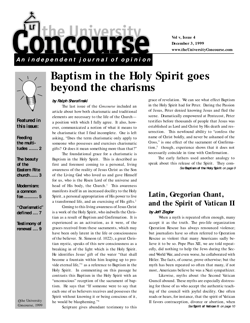Complimentary opponents of modernism
by Michael Houser
As I search through piles of past Concourse issues in the library, if there is one theme which is recurrent, it is the liturgy, and the ongoing campus “debate” between traditional and charismatic spiritualities. The front page article in the latest issue once again raised this issue, and made several great points to which I wish to add.
In my own reflections on this discussion, and my liturgical experience during the few months I have been here, I have had to ask myself wherein exactly the different spiritualities “disagree.” Personally, I have felt myself enriched by both sides of the coin. The vibrant praise and worship, the genuine joy of so many charismatic people, which everyone associates with Steubenville, has been a real eye-opener for me. At the same time, through the Schola Cantorum, I have grown in my appreciation of the musical tradition of the Church, and thanks to the invitation which St. Boniface Church extended to us, I recently experienced for the first time the Liturgy of the Tridentine Rite—a thing of incomparable beauty and richness.
I suppose I should state here that I definitely come from a “traditional” background. I spent my high school years with the Legionaries of Christ, who celebrate the Vatican II liturgy with probably the most reverence and respect for tradition that I have seen.
The question which impressed itself on me as I experienced both of these threads in the liturgy was this: what is the real difference between charismatic and traditional spiritualities—not just in style, but in the theological and philosophical underpinnings of the stylistic difference? After all, “Lex orandi, lex credendi.” (The rule of prayer is the rule of belief.)
Certainly, a major underpinning of traditional liturgy is its theocentric nature: the worship is unmistakeably directed to God. This is made especially clear in the practice of both priest and people facing ad orientem, to the east, offering the Most Holy Sacrifice to the Father through Christ, a practice traditional both in the East and West. This theocentric character is also expressed in the whispered canon, the celestial chant and polyphonic music, and in the “smells and bells.” Liturgy in the tradition of the Universal Church is most clearly an act of worship transcending the secular. (Needless to say, the newer rite of Mass, when celebrated well, also has this character.)
When one approaches the charismatic renewal, a striking contrast presents itself. Here, what hits one is the enthusiasm and spontaneity of the worshippers, the heartfelt, lively singing, the strong emphasis on the gifts of the Holy Spirit and His power, on our need to be radically and personally converted to Christ, as Lord and Savior.
Clearly, the different liturgies have different emphases, and perhaps real disagreements. It may be that certain charismatic practices are not totally in accord with the current liturgical norms of the Church. I am not sure that the use of guitar music in the liturgy is in keeping with the intention of the Council’s statements on Sacred Music. But I feel that by and large, the spirituality of the charismatic movement, and the gifts of the Holy Spirit associated with it are in no intrinsic opposition to the liturgical tradition, but rather are an ally of it.
What is the real enemy of the traditional spirit? That enemy is not the charismatic renewal, but a much different ideology: modernism.1 What do I mean by modernism? It is essentially the denial, not just of certain truths of the Faith, but the whole basis of revealed religion. It is humanistic in a bad way—tending to limit man’s horizons to improving society and helping his fellow man, without much reference to the vertical or supernatural dimension of the faith. Modernism tends to deny the objectivity of revealed truth, or at least to twist its meaning. It usually results in a false tolerance or indifferentism which holds all beliefs to be equally valid, so long as one is sincere. Religion is seen as merely a development of man’s own experience, not as a divine provision for our salvation. Modernism manifests itself not only in a purely horizontal liturgy which lacks a sense of the sacred, but also in an extremely sceptical Biblical criticism which drains the truth value of the Gospels and downplays or denies their divine authorship. No wonder that St. Pius X referred to modernism as “the mixture of all heresies,” and Paul VI spoke of it as “the smoke of Satan entering the Church.”
This modernism, which attempted to hijack the true spirit of the Second Vatican Council, is clearly the antithesis of traditional faith and piety, and of all those devoted to the ancient liturgy of the Church. But is it not equally the enemy of the Charismatic Renewal?
The Charismatic movement, before it reached the Catholic Church in the 1960’s, began in Fundamentalist Pentecostal denominations. And though Fundamentalism tends to be anti-Catholic, it is also the antithesis of modernism. Fundamentalism (or evangelicalism, which is theologically similar)highlights the absolute importance of Christ as Savior, and our need, as sinners, for His grace, while modernism would downplay both Jesus’ divinity and the very sense of sin. Fundamentalism is quite emphatic in its belief that only Christianity, embodied in the Bible, has the full truth, while modernism, as I said earlier, tends to take away from the Bible the character of revelation and promote a view of all religions as equally true.
The qualities of fundamentalism which I have enumerated are mainly good, and are found, in a completed form, in the Catholic Charismatic Renewal. (By this I do not at all mean that the Renewal is essentially Protestant; it is biblical and Christian, and anything biblical and authentically Christian belongs in the Catholic heritage.) In the renewal, we observe apparently supernatural gifts of tongues, prophecy and healing which remind us quite clearly that God’s Spirit is at work in the world. Modernism, on the other hand, is secularization, and would eliminate the need for grace and deny the reality of the miraculous. Modernism is indifferentism, and the Charismatic Renewal is anything but indifferent. (Peter Kreeft’s book Fundamentals of the Faith explains well why orthodox Catholics have much more in common with evangelicals than with modernists.)
Thus, while “traditional” and “charismatic” have different styles of worship, both seem to me to resoundingly affirm the supernatural, the vertical dimension of our faith, the need for grace, the inadequacy of the secular, and the objective truth of revelation, in opposition to the bland psuedo-religion of modernism.
It is not the Charismatic Renewal that is the enemy of liturgical tradition, but the leveling force of modernist liberalism. Franciscan University shows that the Renewal is anything but liberal.
I am no expert on liturgy, and have little experience with the Charismatic Renewal. These reflections are based on my own impressions and experiences, and any critiques would be welcome. I perhaps have exaggerated the dangers of modernism today, but I feel it is something we must guard against. I pray that both the charismatic and traditional elements of our faith may work together at the heart of the Church, and lead her to the springtime of evangelization desired by both John Paul II and Vatican II. As members of the One, Holy, Catholic, Apostolic Church, may we be, as Fr. Scanlan said in his homily at the Latin Mass on Nov.11, “people of tradition, the whole tradition.”
Michael Houser is a freshman philosophy major.
- This is not the place to discuss what role modernism may have played in the post-conciliar reforms. I for one feel that properly interpreted, none of these reforms need be attributed to modernist influence. However, one cannot deny that modernism is a key force in the actual liturgical practice, and the doctrine that is believed, in many parishes today. ↑


